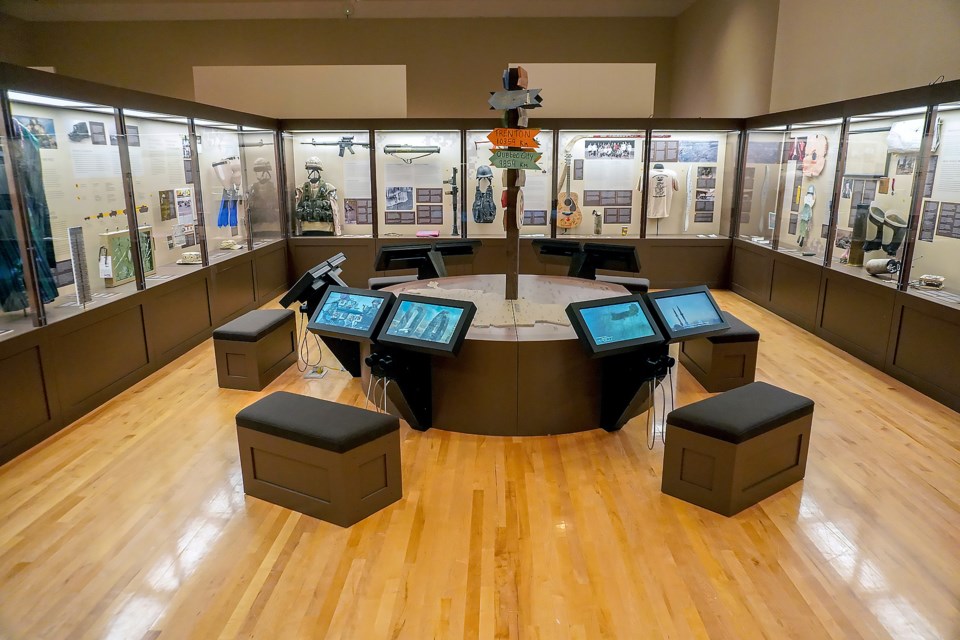CALGARY – It has been 20 years since Sept. 11, 2001, when terrorists crashed airliners into the Twin Towers of the World Trade Centre and the Pentagon. A fourth hijacked plane crashed into a Pennsylvania field after the passengers fought back.
The 9/11 attack killed nearly 3,000 people, including 24 Canadians. It also launched the War on Terror, which led to war in Afghanistan as an international coalition sought to oust the Taliban and dismantle the terrorist organization al Qaeda.
The Canadian Armed Forces joined the coalition in 2001 and fought in Afghanistan until 2014. During the 14-year war, 158 Canadian service members and seven Canadian civilians died.
To mark the 20th anniversary of 9/11, The Military Museums (TMM) in Calgary is sharing the story of Canada’s role in the War in Afghanistan through its latest exhibition, Mission: Afghanistan.
Rory Cory, TMM’s senior curator, said the 1,500-sq.-ft. exhibit, produced in partnership with the Directorate of History and Heritage/Dept. of National Defence, is an in-depth look at Canada’s role on 9/11 and in the war.
“We're trying to present a more complete picture, a more complete chronology of what we did over there. (It’s) an overview of what we did in Afghanistan, but it's still a better chronology of what's been presented to date," Cory said.
Mission: Afghanistan is an immersive, first-person account of the war, Cory said, that features the voices of 200 Canadians connected to the war, including key decision-makers, such as Stephen Harper, Peter MacKay, Lt.-Col. Ian Hope, Lt.-Col. Omer Lavoie and Col. David Fraser. The exhibit also features the voices of the individuals who served overseas with Canada’s Army, Navy and Air Force.
Along with the oral histories, the exhibit also uses text panels, multi-media and many artifacts, including from 9/11 itself.
“You've got the sounds and the sights of 9/11 surrounding you as you come down this long hallway into the exhibit in the larger general hall where you are presented with the full chronology of Canada's role in Afghanistan,” Cory said.
Planning for this $1 million exhibit began six years ago with the intent that Mission: Afghanistan will form the nucleus of a much larger permanent exhibition housed within TMM's expansion project.
“We’ll be able to present a lot more information and a much richer chronology,” said Cory, adding he expects the larger exhibit to fill about 7,500 sq. ft. of the proposed TMM addition.
Along with the research and the writing, organizers used those six years to collect the 200 oral histories from Canadians across the country connected to the war.
Even though Mission: Afghanistan used only snippets of those oral histories, the organizers intend to use the interviews to develop a documentary series. The documentary will allow the museum to explore Canada’s other contributions, such as humanitarian and reconstruction projects.
“There was a whole panoply of different organizations that was called the Whole of Government approach, which was very, a very important part of Canada's role over there, winning hearts and minds basically,” said Cory. “You can’t fight an insurgency purely on a military level.”
The exhibit also incorporates artifacts from 9/11 and the war. These artifacts range from a chunk of metal from one of the planes that crashed into the Twin Towers, a motorcycle used in a failed suicide bomb attack and equipment used by Canadians in Afghanistan.
Mission: Afghanistan closes at TMM on Nov. 22. It will then travel to the Royal Canadian Artillery Museum in Shiloh, MB.
To make Mission: Afghanistan as accessible as possible, two versions will travel across Canada and beyond. The first version is available for museums capable of housing the artifacts. The second version, which incorporates just the graphics and the text panels, is meant for locations other than museums.
“We want the story to travel as broadly as possible all across Canada; so, it just gives us a lot more flexibility,” said Cory.
As a historian, Cory said working with the stories of veterans of a more recent conflict allowed him to share overlooked themes and stories.
“One of the things that we've talked about in this exhibit that you don't find historians talking about a lot or the media talking a lot about are the wounded in Afghanistan,” said Cory.
“You can find a lot of information about the people who were killed and that's the same for a lot of the past conflicts, as well. For this exhibit, we’re talking a lot about the other sacrifices, so people that have lost limbs, people that have suffered from PTSD.”
As a result, Cory said he’s been able to use objects such as prosthetic limbs and paintings created in art therapy programs by veterans with PTSD.
“The exhibit is meant to bring home to the viewer what the physical sacrifices were. We've got several prosthetics in there, climbing prosthetics, swimming prosthetics, running prosthetics. So, it's really a physical and visceral connection with the loss that this person has given to their country.”
Alongside Mission: Afghanistan, the Founders’ Gallery is hosting Tensile Strength: Weavers and War. This exhibit displays the Afghan war rugs held in the collections of the Nickle Galleries at the University of Calgary. Afghan war rugs first appeared following the Soviet invasion of Afghanistan in 1979. They tend to feature scenes, stories, people and places linked to war in Afghanistan.
For more information, visit: www.themilitarymuseums.com.




